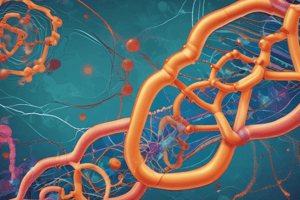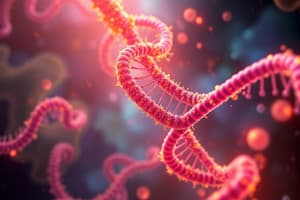Podcast
Questions and Answers
What is the primary role of RNA polymerase during transcription?
What is the primary role of RNA polymerase during transcription?
- To unwind DNA for replication.
- To splice introns out of pre-mRNA.
- To synthesize RNA using a DNA template. (correct)
- To degrade incorrectly synthesized mRNA.
Which of the following best describes the function of a gene?
Which of the following best describes the function of a gene?
- It is a lipid molecule that stores energy in the cell.
- It is a segment of RNA that regulates protein degradation.
- It is a carbohydrate that provides structural support to the cell.
- It is the fundamental unit of heredity that carries information for protein synthesis. (correct)
In eukaryotes, where does transcription take place?
In eukaryotes, where does transcription take place?
- Ribosome
- Cytoplasm
- Nucleus (correct)
- Mitochondria
Which of the following is a key difference between gene structure in prokaryotes and eukaryotes?
Which of the following is a key difference between gene structure in prokaryotes and eukaryotes?
What is the role of the promoter region in a gene?
What is the role of the promoter region in a gene?
Which of the following RNA types is a mature mRNA molecule?
Which of the following RNA types is a mature mRNA molecule?
What is the primary function of tRNA?
What is the primary function of tRNA?
Which of the following best describes the purpose of post-transcriptional modifications in eukaryotes?
Which of the following best describes the purpose of post-transcriptional modifications in eukaryotes?
What modification typically occurs at the 5' end of eukaryotic pre-mRNA during processing?
What modification typically occurs at the 5' end of eukaryotic pre-mRNA during processing?
What is the significance of the poly-A tail added to eukaryotic mRNA?
What is the significance of the poly-A tail added to eukaryotic mRNA?
What is the function of snRNA regarding pre-mRNA?
What is the function of snRNA regarding pre-mRNA?
During splicing, what are the coding regions that are joined together to form the mature mRNA molecule called?
During splicing, what are the coding regions that are joined together to form the mature mRNA molecule called?
What is the main purpose of pre-mRNA splicing?
What is the main purpose of pre-mRNA splicing?
What is the most common termination sequence in eukaryotes during transcription?
What is the most common termination sequence in eukaryotes during transcription?
Alternative splicing allows eukaryote cells to do what?
Alternative splicing allows eukaryote cells to do what?
What describes the central dogma of molecular biology?
What describes the central dogma of molecular biology?
What do signals in the nucleotide sequence tell bacterial RNA polymerase?
What do signals in the nucleotide sequence tell bacterial RNA polymerase?
Which of these steps are included in the process of transcription?
Which of these steps are included in the process of transcription?
In the context of gene expression, what refers to the transfer of genetic information from DNA into the primary structure of a protein?
In the context of gene expression, what refers to the transfer of genetic information from DNA into the primary structure of a protein?
What is the crucial role of aminoacyl-tRNA synthetase in translation?
What is the crucial role of aminoacyl-tRNA synthetase in translation?
What does the presence of a poly-A tail signify?
What does the presence of a poly-A tail signify?
What is the start codon that begins translation in mRNA?
What is the start codon that begins translation in mRNA?
Where does translation take place in prokaryotes?
Where does translation take place in prokaryotes?
During translation, where does the tRNA bind to its respective codon?
During translation, where does the tRNA bind to its respective codon?
Which is the direct role of ribosomes in protein synthesis?
Which is the direct role of ribosomes in protein synthesis?
During translation, what are 3 of the stop codons?
During translation, what are 3 of the stop codons?
What is the process of translation is mainly defined by?
What is the process of translation is mainly defined by?
What occurs when the ribosome encounters a stop codon on the mRNA molecule during translation?
What occurs when the ribosome encounters a stop codon on the mRNA molecule during translation?
What part of mRNA does a ribosome bind to, to perform translation?
What part of mRNA does a ribosome bind to, to perform translation?
Which is the last step in the cycle of translation?
Which is the last step in the cycle of translation?
What happens after the RNA polymerase encounters a termination signal from a specific nucleotide sequence?
What happens after the RNA polymerase encounters a termination signal from a specific nucleotide sequence?
Following translation, what is the purpose of post-translational modification of a protein?
Following translation, what is the purpose of post-translational modification of a protein?
Which of the following is an example of post-translational modification?
Which of the following is an example of post-translational modification?
Which antibiotic blocks the peptidyl transferase reaction on ribosomes?
Which antibiotic blocks the peptidyl transferase reaction on ribosomes?
How does ubiquitination lead to protein degradation?
How does ubiquitination lead to protein degradation?
Which is a characteristic that is shared by both DNA replication and transcription?
Which is a characteristic that is shared by both DNA replication and transcription?
What does the small subunit of a ribosome do for translation?
What does the small subunit of a ribosome do for translation?
What role do molecular chaperones play in protein folding?
What role do molecular chaperones play in protein folding?
What term refers to the degradation of proteins?
What term refers to the degradation of proteins?
How does translation initiate in the correct location?
How does translation initiate in the correct location?
Which of the following is a characteristic of the genetic code?
Which of the following is a characteristic of the genetic code?
Flashcards
Central Dogma
Central Dogma
The flow of genetic information from DNA to RNA to protein.
Gene
Gene
A segment of DNA that contains instructions for making a specific protein or RNA molecule.
Promoter
Promoter
A region of DNA where RNA polymerase binds to initiate transcription.
Terminator
Terminator
Signup and view all the flashcards
Introns
Introns
Signup and view all the flashcards
Exons
Exons
Signup and view all the flashcards
Pre-mRNA
Pre-mRNA
Signup and view all the flashcards
mRNA
mRNA
Signup and view all the flashcards
tRNA
tRNA
Signup and view all the flashcards
rRNA
rRNA
Signup and view all the flashcards
Transcription
Transcription
Signup and view all the flashcards
Translation
Translation
Signup and view all the flashcards
Post-transcriptional modification
Post-transcriptional modification
Signup and view all the flashcards
5' Capping
5' Capping
Signup and view all the flashcards
Polyadenylation
Polyadenylation
Signup and view all the flashcards
Pre-mRNA splicing
Pre-mRNA splicing
Signup and view all the flashcards
Alternative splicing
Alternative splicing
Signup and view all the flashcards
Codon
Codon
Signup and view all the flashcards
Genetic code
Genetic code
Signup and view all the flashcards
Reading frame
Reading frame
Signup and view all the flashcards
tRNA (transfer RNA)
tRNA (transfer RNA)
Signup and view all the flashcards
Aminoacyl-tRNA synthetases
Aminoacyl-tRNA synthetases
Signup and view all the flashcards
Ribosomes
Ribosomes
Signup and view all the flashcards
Elongation (translation)
Elongation (translation)
Signup and view all the flashcards
Start codon
Start codon
Signup and view all the flashcards
Stop codons
Stop codons
Signup and view all the flashcards
Post-translational modification
Post-translational modification
Signup and view all the flashcards
Protein Degradation
Protein Degradation
Signup and view all the flashcards
Ubiquitin-Proteasome Pathway
Ubiquitin-Proteasome Pathway
Signup and view all the flashcards
Study Notes
From DNA to Protein
- The lecture covers the flow of genetic information from DNA to protein, focusing on transcription and translation.
Central Dogma
- DNA serves as the blueprint for RNA synthesis, also known as transcription.
- RNA acts as an order form for protein synthesis, also as translation.
- Proteins are the functional parts made from amino acids
Regulation of Gene Expression
- Gene expression involves two main steps: transcription (DNA to RNA) and translation (RNA to protein).
Eukaryotes vs. Prokaryotes
- In eukaryotes, transcription occurs in the nucleus where pre-mRNA is synthesized and then processed into mRNA.
- Post-transcriptional processing is needed for mRNA production
- Eukaryotes have mitochondria and chloroplasts
- In prokaryotes, transcription happens in the cytoplasm.
Gene
- A gene is a fundamental hereditary unit carrying information from one generation to the next.
- Genes are sections of DNA within a chromosome coding for protein synthesis.
- A basic gene structure consists of a promoter, RNA coding sequence, and terminator.
Gene Structure Differences
- Prokaryotic genes have a coding region.
- Eukaryotic genes contain coding regions (exons) and noncoding regions (introns).
Gene Size and Structure
- The human β-globin gene consists of approximately 2000 nucleotide pairs.
- The human Factor VIII gene consists of approximately 200,000 nucleotide pairs.
Bacterial RNA Polymerase
- Signals in the nucleotide sequence indicate where bacterial RNA polymerase should start and stop transcription.
Transcription
- Transcription is the process where genetic information from DNA transfers into RNA through RNA synthesis.
- Transcription produces RNA and is complimentary to one strand of DNA.
Transcription in Prokaryotes
- Takes place in the cytoplasm
- DNA is unwound and RNA is synthesized by RNA polymerase
- The RNA coding sequence transcribes into mRNA
Transcription in Eukaryotes
- Transcription occurs in the nucleus.
- The RNA is synthesized in two steps
- Pre-mRNA is produced through transcription of eukaryotes. Then pre-mRNA undergoes RNA processing to produce messenger mRNA (mRNA).
Process of Transcription
- Transcription proceeds through three steps: initiation, elongation, and termination.
Initiation of Transcription
- Initiation begins at the promoter, a DNA sequence that includes CAAT, TATA, and GC boxes.
- Promoters are located at the 5' end of a gene.
RNA Polymerases
- RNA polymerase I synthesizes pre-rRNA (45S).
- RNA polymerase II synthesizes pre-mRNA, snRNA, and microRNA.
- RNA polymerase III synthesizes tRNA, rRNA (5S), and other microRNA.
- RNA polymerases IV & V synthesize plant's RNA.
- Other polymerases synthesize mitochondrial RNA, chloroplast RNA, and prokaryotic RNA.
DNA Template
- Only one DNA strand acts as a template for RNA synthesis.
- The promoter determines which DNA strand transcribes.
Template Determination
- When the promoter is on the left, the lower strand is the template, and the upper strand is the coding strand.
- When the promoter is on the right, the upper strand is the template, and the lower strand is the coding strand.
Gene Direction
- Genes can be located on both DNA strands.
- RNA transcript for gene b reads from right to left
- RNA transcript for gene a reads from left to right
Elongation of Transcription
- After RNA polymerase starts RNA synthesis, most initial transcription factors are released.
- Elongation factors help RNA polymerase unwind DNA further and stabilize the new pre-mRNA.
Termination of Transcription
- Termination occurs when RNA polymerase encounters a specific nucleotide sequence termination signal.
- In eukaryotes, the most common termination sequence is AATAAA.
Transcription Summary
- RNA polymerase binds to the promoter and unwinds local DNA area
- RNA synthesis begins with initiation
- RNA elongation follows in the 5' to 3' direction.
- Transcription ends at the termination signal.
Replication and Transcription
- Both use one strand of DNA as a template and follow the principle of complementarity.
- Transcription produces RNA, which doesn't remain attached to DNA and are copied from a limited region.
- Transcription doesn't need a primer.
- Amount of RNA is controlled per gene expression.
- Eukaryotic RNAs undergo major changes before leaving the nucleus.
Post-Transcriptional Modification
- post-transcriptional mRNA processing readies mRNA for translation
Pre-mRNA Processing
- Pre-mRNA processing occurs only in eukaryotic cells
- Primary transcript RNA (pre-mRNA) converts to mature messenger RNA (mRNA) in this process.
- Processing takes place in the nucleus during transcription.
5' Modification of pre-mRNA
- RNA capping and polyadenylation occur during pre-mRNA processing.
- Capping involves adding a "cap" and occurs at transcription's beginning.
- Capping takes place after the growing RNA strand reaches ~25 nucleotides.
Mechanism of Capping
- Capping enzymes attach a 7-methyl-guanosine "cap" to the transcript's 5' terminal base through a 5' to 5' triphosphate bridge.
Significance of the 5' Cap
- Regulates nuclear exporting.
- Prevents degradation by exonucleases.
- Promotes the initiation of translation.
- Promotes 5' proximal intron excision in splicing.
3' Modification of pre-mRNA
- Polyadenylation occurs through the addition of a poly-A tail.
- This step occurs at the end of transcription upon reaching the termination signal.
Mechanism of Polyadenylation
- An endonuclease recognizes the termination signal and cleaves the RNA.
- Poly(A) polymerase adds ~200 adenines at the 3' end of the mRNA.
Significance of the 3' Tail
- The poly-A tail differentiates mRNA from other types of RNA, it also ensures proper intron splicing.
- mRNA without a poly-A tail cannot leave the nucleus
Pre-mRNA Splicing
- Pre-mRNA splicing removes introns from pre-mRNA and connects exons to form a continuous coding sequence.
- Splicing occurs in the nucleus
- Involves spliceosomes, snRNPs and proteins
Special Nucleotide Sequences
- Specific nucleotide sequences signal the start and end of an intron.
Pre-mRNA Splicing Steps
- Occurs after the complete synthesis and cap of pre-mRNA.
- Catalyzed by a spliceosome protein complex.
- Includes proteins (endonuclease and ligase) and small nuclear ribonucleoproteins (snRNPs).
Mechanism of Pre-mRNA Splicing
- The RNA portion of snRNPs base-pairs with sequences to signal splicing.
- Additional snRNPs bind, assembling the spliceosome resulting in spliced products.
A Lariat Structure
- Branch point adenine attacks the 5' splice site.
- The intron’s cut end loops to the adenine and forms a loop.
- Forming a loop in the intron
Significance of Splicing
- Splicing removes non-coding introns from RNA and produces a mature mRNA with only protein-coding exons.
Alternative Splicing
- Alternative splicing allows different combinations of exons creating multiple forms of protein.
Exon and Intron Length
- Exon and intron length have a range and vary between different species.
Post-transcriptional Summary
- The post-transcriptional modifications of pre-mRNA lead to a change within the nucleus
mRNA Differences
- Prokaryotic mRNA doesn't have a 5' cap or poly-A tail
- Eukaryotic mRNA has a 5' cap and a poly-A tail
mRNA and Nuclear Pore
- "Export-ready" mRNA molecules transport throughout a nuclear pore in the membrane.
Translation
- Translation is the process where information from mRNA transfers to amino acids to create a polypeptide.
- Protein synthesis through is a result of polypeptide structure and synthesis
Translation location
- In eukaryotes, translation happens outside the nucleus in the cytoplasm
- In prokaryotes, transcription happens in also happens in the cytosol
Molecular Components
- Essential components for translation include: mRNA, amino acids, tRNAs, ribosomes, enzymes, and energy.
Codon
- Codons are part of a mRNA molecule to code for protein synthesis.
- Each codon has three nucleotides and each codon makes on type of amino acid.
Genetic Code Properties
- The genetic code is universal where translation is a set of rules to express it.
- Non-overlapping groups are required.
- There are no spaces during coding.
- Has redundancy.
- 64 possible codons but only 20 amino acids
- Has a start codon.
- Has three non-coding stop codons.
- Not all amino acids have the same amount of codons (some are more common)
Reading Frame
- The start codon typically initiates translation after the mRNA binds to the Ribosomes.
Translation Reading Frames
- There are three possible outcomes that translate nucleotide sequence to amino acid sequence with varying amino acid outcomes.
tRNA Binding site and Structure
- Three nucleotides on the cloverleaf structure pair with the mRNA
- Amino acids attach at the 3' end
Aminoacyl-tRNA Synthetase
- The enzyme causes a high energy bond for amino acids to bind
- tRNA synthetase links the amino acid and mRNA codon in the 5' end
Decoding by Ribosomes
- The mRNA message decodes by Ribosomes to translate proteins
Eukaryotic Ribosome
- Made of proteins and rRNA, eukaryotic ribosome is composed of small and large subunits for translation.
RNA binding sites
- The ribosome contains an E site, P site, and A site.
- mRNA binding also takes place, near the complex
Steps of Translation
- Aminoacyl-tRNA binds to the A site.
- Peptide and peptide bonds come in forming the ribosome
- Translocation of unit causes shift in RNA molecule
Specific Codons
- All three codons in mRNA Signal the Ribosome to Start and to Stop Protein Synthesis
- Translation happens when the AUG codon is reached.
- An initiator tRNA binds (methionine (Met.)
Translation Steps
- The elongation and transfer of tRNA to build the protein synthesis. Proteins then undergo a post shift in position from this translation.
Inhabitors
- Some antibiotics are inhabitors to expression of proteins
Studying That Suits You
Use AI to generate personalized quizzes and flashcards to suit your learning preferences.




